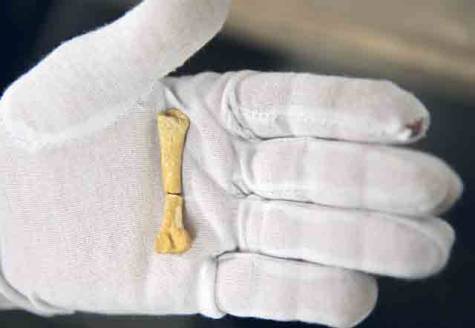
"So far this could be the earliest human fossil found in the Asia-Pacific region. The presence of humans in Luzon shows these early humans already possessed knowledge of seacraft-making in this early period," Dr Armand Mijares, leader of a team of archaeologists from the University of the Philippines that found the fossil in Callao Cave in Cagayan Province, northern Luzon, told GMA-7.
The bone, found in an extensive cave network, predates the 47,000-year-old Tabon Man that is previously known as the first human to have lived in the country, said Taj Vitales, a researcher with the Philippina national museum's archaeology section.
"This would make it the oldest human remains ever found in the Philippines," Vitales told AFP.
Archaeologists dug up the third metatarsal bone of the right foot in 2007 in the Callao caves near Penablanca, about 335 kilometres (210 miles) north of Manila. Their report on "Callao Man" was released in the latest edition of the Journal of Human Evolution after tests in France established the fossil's age, said Mijares.
"It broke the barriers," Mijares said, explaining that previous evidence put the first human settlements in the Philippines and nearby islands around Tabon Man. It pushed that back to nearly 70,000 years."
"During the excavation we were only finding animal remains. [Then] my colleague Dr Phil Piper, our team's zoo-archaeologist, told me: 'Mandy, this is a human bone'. When we verified that it was a human bone, I knew that we discovered something very important," said Mijares whose team started digging in Peñablanca town four years ago. "I am shocked and elated by the discovery," said Mijares.
Tools
Sceptical scientists have asked how the Callao Man could have killed animals that preyed on him if the archeological team never found stone tools on the same layer of earth where the sensational foot bone was unearthed.
In response, Mijares said: "We can only speculate that they were using different tools. From our initial analysis of the cut marks on the animal bones, they could have used organic tools such as bamboo which is ubiquitous in the region."
Cut marks on bones of deer and wild boar found around it suggest the Callao Man could have hunted and was skilled with tools.
"This individual was small-bodied. It's difficult to say whether he was male or female," he said.
Mijares stressed the finding that Callao Man belongs to Homo sapiens was still only provisional. Some of the bone's features were similar to Homo habilis and Homo floresiensis - which are distinct species from humans. Existing evidence suggests that Homo sapiens, modern man, first appeared in Africa about 200,000 years ago.
Homo habilis is considered a predecessor to Homo sapiens while Homo floresiensis is thought to be a short, human-like species that once existed on an Indonesian island in the Late Pleistocene stage.



OK, they have a find. But one bone? We have been through this. So many textbooks are still riddled with pictures of "cavemen" and their "mate and children" all from what turned out to be a pig tooth. From a pig tooth they even drew what they wore and how they lived. From a pig tooth?
I am eager to see what else turns up on this. but ...right now, it is one bone.